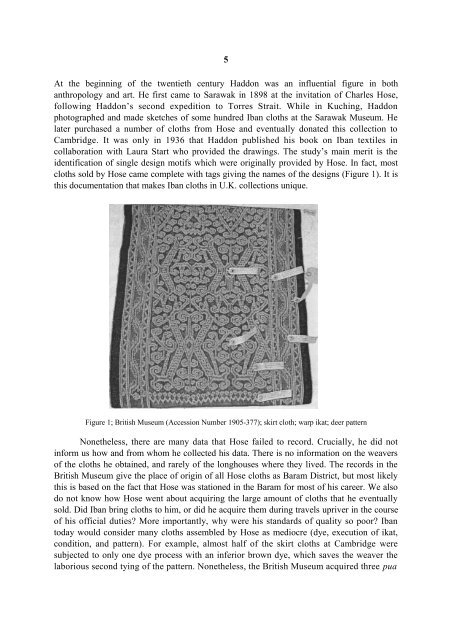download - OATG. Oxford Asian Textile Group
download - OATG. Oxford Asian Textile Group
download - OATG. Oxford Asian Textile Group
Create successful ePaper yourself
Turn your PDF publications into a flip-book with our unique Google optimized e-Paper software.
5<br />
At the beginning of the twentieth century Haddon was an influential figure in both<br />
anthropology and art. He first came to Sarawak in 1898 at the invitation of Charles Hose,<br />
following Haddon’s second expedition to Torres Strait. While in Kuching, Haddon<br />
photographed and made sketches of some hundred Iban cloths at the Sarawak Museum. He<br />
later purchased a number of cloths from Hose and eventually donated this collection to<br />
Cambridge. It was only in 1936 that Haddon published his book on Iban textiles in<br />
collaboration with Laura Start who provided the drawings. The study’s main merit is the<br />
identification of single design motifs which were originally provided by Hose. In fact, most<br />
cloths sold by Hose came complete with tags giving the names of the designs (Figure 1). It is<br />
this documentation that makes Iban cloths in U.K. collections unique.<br />
Figure 1; British Museum (Accession Number 1905-377); skirt cloth; warp ikat; deer pattern<br />
Nonetheless, there are many data that Hose failed to record. Crucially, he did not<br />
inform us how and from whom he collected his data. There is no information on the weavers<br />
of the cloths he obtained, and rarely of the longhouses where they lived. The records in the<br />
British Museum give the place of origin of all Hose cloths as Baram District, but most likely<br />
this is based on the fact that Hose was stationed in the Baram for most of his career. We also<br />
do not know how Hose went about acquiring the large amount of cloths that he eventually<br />
sold. Did Iban bring cloths to him, or did he acquire them during travels upriver in the course<br />
of his official duties More importantly, why were his standards of quality so poor Iban<br />
today would consider many cloths assembled by Hose as mediocre (dye, execution of ikat,<br />
condition, and pattern). For example, almost half of the skirt cloths at Cambridge were<br />
subjected to only one dye process with an inferior brown dye, which saves the weaver the<br />
laborious second tying of the pattern. Nonetheless, the British Museum acquired three pua
















